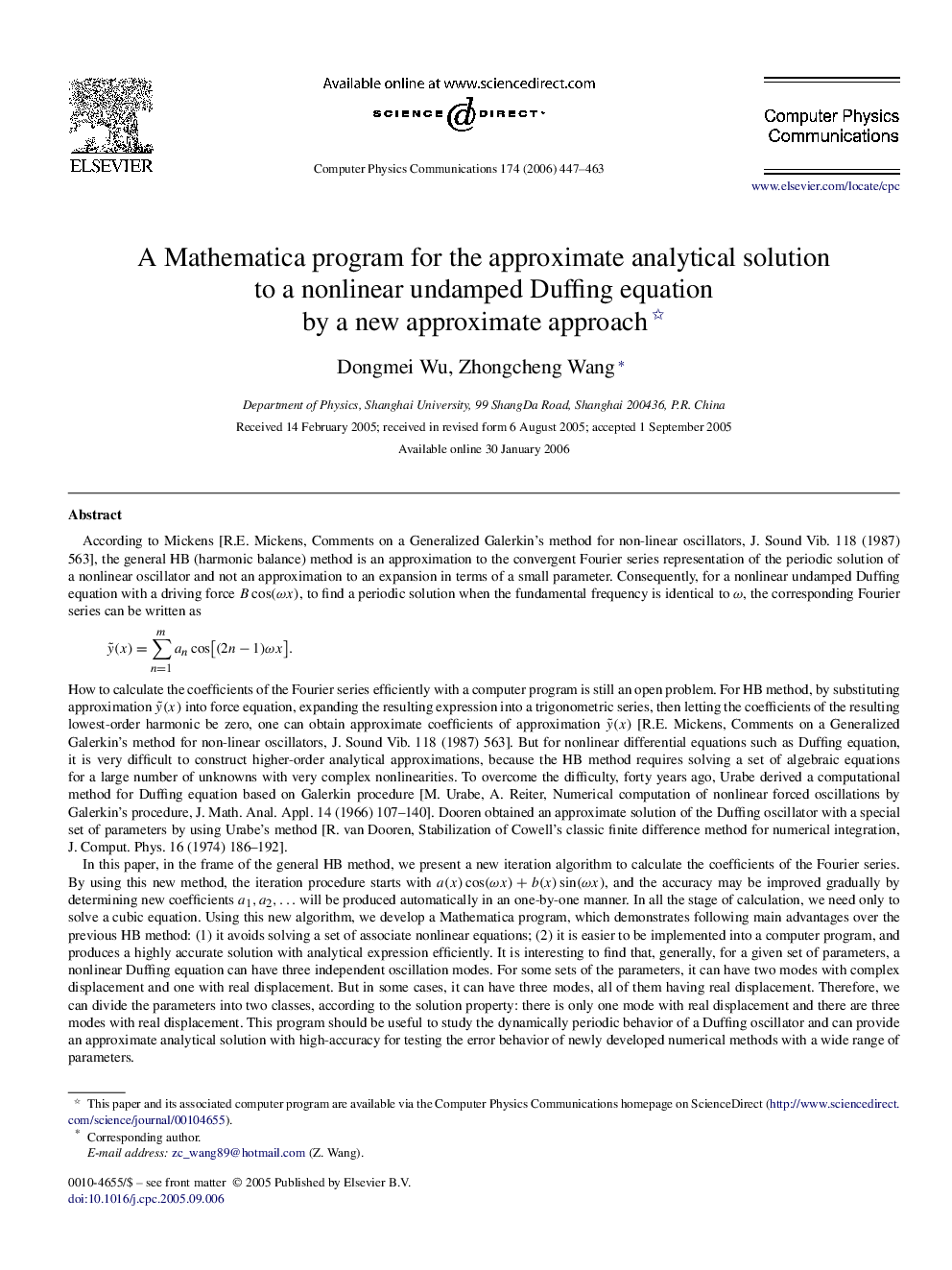| کد مقاله | کد نشریه | سال انتشار | مقاله انگلیسی | نسخه تمام متن |
|---|---|---|---|---|
| 503799 | 863818 | 2006 | 17 صفحه PDF | دانلود رایگان |

According to Mickens [R.E. Mickens, Comments on a Generalized Galerkin's method for non-linear oscillators, J. Sound Vib. 118 (1987) 563], the general HB (harmonic balance) method is an approximation to the convergent Fourier series representation of the periodic solution of a nonlinear oscillator and not an approximation to an expansion in terms of a small parameter. Consequently, for a nonlinear undamped Duffing equation with a driving force Bcos(ωx)Bcos(ωx), to find a periodic solution when the fundamental frequency is identical to ω, the corresponding Fourier series can be written asy˜(x)=∑n=1mancos[(2n−1)ωx]. How to calculate the coefficients of the Fourier series efficiently with a computer program is still an open problem. For HB method, by substituting approximation y˜(x) into force equation, expanding the resulting expression into a trigonometric series, then letting the coefficients of the resulting lowest-order harmonic be zero, one can obtain approximate coefficients of approximation y˜(x) [R.E. Mickens, Comments on a Generalized Galerkin's method for non-linear oscillators, J. Sound Vib. 118 (1987) 563]. But for nonlinear differential equations such as Duffing equation, it is very difficult to construct higher-order analytical approximations, because the HB method requires solving a set of algebraic equations for a large number of unknowns with very complex nonlinearities. To overcome the difficulty, forty years ago, Urabe derived a computational method for Duffing equation based on Galerkin procedure [M. Urabe, A. Reiter, Numerical computation of nonlinear forced oscillations by Galerkin's procedure, J. Math. Anal. Appl. 14 (1966) 107–140]. Dooren obtained an approximate solution of the Duffing oscillator with a special set of parameters by using Urabe's method [R. van Dooren, Stabilization of Cowell's classic finite difference method for numerical integration, J. Comput. Phys. 16 (1974) 186–192].In this paper, in the frame of the general HB method, we present a new iteration algorithm to calculate the coefficients of the Fourier series. By using this new method, the iteration procedure starts with a(x)cos(ωx)+b(x)sin(ωx)a(x)cos(ωx)+b(x)sin(ωx), and the accuracy may be improved gradually by determining new coefficients a1,a2,…a1,a2,… will be produced automatically in an one-by-one manner. In all the stage of calculation, we need only to solve a cubic equation. Using this new algorithm, we develop a Mathematica program, which demonstrates following main advantages over the previous HB method: (1) it avoids solving a set of associate nonlinear equations; (2) it is easier to be implemented into a computer program, and produces a highly accurate solution with analytical expression efficiently. It is interesting to find that, generally, for a given set of parameters, a nonlinear Duffing equation can have three independent oscillation modes. For some sets of the parameters, it can have two modes with complex displacement and one with real displacement. But in some cases, it can have three modes, all of them having real displacement. Therefore, we can divide the parameters into two classes, according to the solution property: there is only one mode with real displacement and there are three modes with real displacement. This program should be useful to study the dynamically periodic behavior of a Duffing oscillator and can provide an approximate analytical solution with high-accuracy for testing the error behavior of newly developed numerical methods with a wide range of parameters.Program summaryTitle of program:AnalyDuffing.nbCatalogue identifier:ADWR_v1_0Program summary URL:http://cpc.cs.qub.ac.uk/summaries/ADWR_v1_0Program obtainable from: CPC Program Library, Queen's University of Belfast, N. IrelandLicensing provisions:noneComputer for which the program is designed and others on which it has been tested:the program has been designed for a microcomputer and been tested on the microcomputer.Computers:IBM PCInstallations:the address(es) of your computer(s)Operating systems under which the program has been tested:Windows XPProgramming language used:Software Mathematica 4.2, 5.0 and 5.1No. of lines in distributed program, including test data, etc.:23 663No. of bytes in distributed program, including test data, etc.:152 321Distribution format:tar.gzMemory required to execute with typical data:51 712 BytesNo. of bits in a word:No. of processors used:1Has the code been vectorized?:noPeripherals used:noProgram Library subprograms used:noNature of physical problem:To find an approximate solution with analytical expressions for the undamped nonlinear Duffing equation with periodic driving force when the fundamental frequency is identical to the driving force.Method of solution:In the frame of the general HB method, by using a new iteration algorithm to calculate the coefficients of the Fourier series, we can obtain an approximate analytical solution with high-accuracy efficiently.Restrictions on the complexity of the problem:For problems, which have a large driving frequency, the convergence may be a little slow, because more iterative times are needed.Typical running time:several secondsUnusual features of the program:For an undamped Duffing equation, it can provide all the solutions or the oscillation modes with real displacement for any interesting parameters, for the required accuracy, efficiently. The program can be used to study the dynamically periodic behavior of a nonlinear oscillator, and can provide a high-accurate approximate analytical solution for developing high-accurate numerical method.
Journal: Computer Physics Communications - Volume 174, Issue 6, 15 March 2006, Pages 447–463